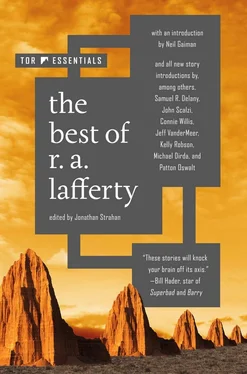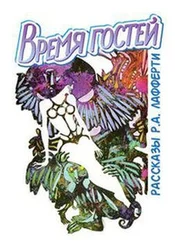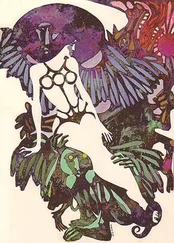She poised the hammer over the mayor’s gold watch, now on the floor.
“I have to wait a few seconds. This can’t be hurried. It’ll only be a little while.”
The second hand swept around to the point that was preordained for it before the world began. Clarissa suddenly brought down the hammer with all her force on the beautiful gold watch.
“That’s all,” she said. “Your troubles are over. See, there is Blanche Manners’s cat on the sidewalk just where she was seven days ago.”
And the cat was back.
“Now let’s go down to the Plugged Nickel and watch the fireplugs come back.”
They had only a few minutes to wait. It came from nowhere and clanged into the street like a sign and a witness.
“Now I predict,” said Clarissa, “that every single object will return exactly seven days from the time of its disappearance.”
The seven-day terror had ended. The objects began to reappear.
“How,” asked the mayor, “did you know they would come back in seven days?”
“Because it was a seven-day disappearer that Clarence made. I also know how to make a nine-day, a thirteen-day, a twenty-seven-day, and an eleven-year disappearer. I was going to make a thirteen-year one, but for that you have to color the ends with the blood from a little boy’s heart, and Cyril cried every time I tried to make a good cut.”
“You really know how to make all of these?”
“Yes. But I shudder if the knowledge should ever come into unauthorized hands.”
“I shudder, too, Clarissa. But tell me, why did you want the chemicals?”
“For my chemistry set.”
“And the black velvet?”
“For doll dresses.”
“And the pound of rock candy?”
“How did you ever get to be mayor of this town if you have to ask questions like that? What do you think I wanted the rock candy for?”
“One last question,” said the mayor. “Why did you smash my gold watch with the hammer?”
“Oh,” said Clarissa, “that was for dramatic effect.”
Introduction by Cat Rambo
In “Boomer Flats,” which originally appeared in If Magazine in 1971, Lafferty expands on the internal mythology of his work and returns to familiar themes. Evolution, and how humans fit into it through spontaneous evolutionary leaps, features in other stories such as “Ginny Wrapped in the Sun” and “In Deepest Glass.” Lafferty asserted that storytelling was a manifestation of ancestry and that storytellers belonged “to the old ‘red-bone people.’” The journey to Boomer Flats brings the reader to a strange town where those people walk daily.
To those who know who Ivan Sanderson is, the clue is there from the very first line: eminent scientists Arpad Arkabaranan, Willy McGilly, and Dr. Velikof Vonk, declaring themselves his spiritual offspring, are in search of Fortean phenomena, specifically the ABSM (Abominable Snowman). It’s a literal wild-goose chase, as McGilly notes, referring to the hundreds of mud geese in flight across the sky.
This sort of linguistic play, the metaphorical made real, ripples through the story, and even sometimes slides it over into poetry’s realm, such as the repeated reassurance Crayola Catfish gives the eminent scientists about their drinks, “They’re fixing them for you now. I’ll bring them after a while.”
Boomer Flats is a shadow town, an echo of the town of Boomer. “Something a little queer and primordial about the whole place!” Lafferty warns the reader, who already knows we’re wandering in strange territory.
The three eminent scientists know it too. Dr. Velikof Vonk’s eyes grin “out of deep folk memory,” as he begins to drink what Crayola has brought him: a clay cup that “smelled strongly of river, perhaps of interstadial river.” The drinks, the Green Snake Snorters, move the trio into a strange mythopoetic world in washes, like a television show’s set where each cut-away and back reveals odder and odder details changed and added. The prose becomes stranger and stranger at the same time, moving into deeper and deeper waters of wordplay. That shabby man playing dominoes is a bear. Pieces are falling off a man called the Comet. And then, the giants enter, standing around the edges of the room in their black hats. This is where the legends dwell, almost as though Boomer Flats is the secret heart of Lafferty’s cosmos.
The three eminent scientists are specifically identified as three Magi, but what they find is not an answer in the form of the Christ Child, but more and more questions about the world itself. Instead the ending turns back to story’s heart in a way that pulls the reader further in and farther out, so to speak. This is Lafferty at his luminiferous best, slipstream before the term was ever invented.
“In the tracks of our spiritual father Ivan Sanderson we may now have trailed a clutch of ABSMs to their lair,” the eminent scientist Arpad Arkabaranan was saying in his rattling voice. “And that lair may not be a mountain thicket or rain forest or swamp, but these scrimpy red clay flats. I would almost give my life for the success of this quest, but it seems that it should have a more magnificent setting.”
“It looks like a wild-goose chase,” the eminent scientist Willy McGilly commented. But no, Willy was not downgrading their quest. He was referring to the wild geese that rose about them from the edges of the flats with clatter and whistle and honk. This was a flight-way, a chase of theirs. There were hundreds of them if one had the fine eyes to pick them out from the background. “Mud geese,” Willy said. “We don’t see as many of them as when I was a boy.”
“I do not, and I am afraid that I will not, believe in the ABSMs,” said the eminent scientist Dr. Velikof Vonk, stroking his—(no he didn’t, he didn’t have one)—stroking his jaw, “and yet this is the thing that I also have most desired, to find this missing link finally, and to refute all believers in the other thing.”
“We can’t see the chain for the links,” said Willy McGilly. “I never believed that any of them was missing. There’s always been too many of them for the length of the chain: that’s the trouble.”
“I’ve traveled a million miles in search of them,” said Arpad. “I’ve pretty well probed all the meager ribs of the world in that travel. My fear has always been that I’d miss them by a trick, even that in some unaccountable way I wouldn’t know them when I found them. It would be ironic if we did find them in such a place as this: not a wild place, only a shabby and overlooked place.”
“My own fear has been that when I finally gazed on one I would wake with a start and find that I had been looking in a mirror,” said Velikof. “There must be some symbolism here that I don’t understand. What is your own anticipation of them, Willy?”
“Oh, coming back to people I’ve always liked. There used to be a bunch of them on the edge of my hometown,” Willy McGilly said. “Come to think of it, there used to be a bunch of them on the edge of every hometown. Now they’re more likely to be found right in the middle of every town. They’re the scrubs, you know, for the bottoming of the breed.”
“What are you talking about, Willy?” Arpad asked sharply.
What they were all talking about was ABSMs.
Every town in the south part of that county has a shadow or secondary. There is Meehan, and Meehan Corners; Perkins, and Perkins Corner; Boomer, and Boomer Flats. The three eminent scientists were driving the three miles from Boomer to Boomer Flats looking for the bones, and hopefully even the living flesh, of a legend. It was that of the missing link, of the Abominable Snowman, the ABSM. It wasn’t snowy country there, but the so-called Snowmen have been reported in every sort of climate and countryside. The local legend, recently uncovered by Arpad, was that there was a non-African non-Indian “people of color” living in the neighborhood of Boomer Flats, “between the sand-bush thickets and the river.” It was said that they lived on the very red mud banks of the river, and that they lived a little in the river itself.
Читать дальше




![Рафаэль Лафферти - Дни, полные любви и смерти. Лучшее [сборник litres]](/books/385123/rafael-lafferti-dni-polnye-lyubvi-i-smerti-luchshe-thumb.webp)
![Рафаэль Лафферти - Лучшее [Сборник фантастических рассказов]](/books/401500/rafael-lafferti-luchshee-sbornik-fantasticheskih-ra-thumb.webp)